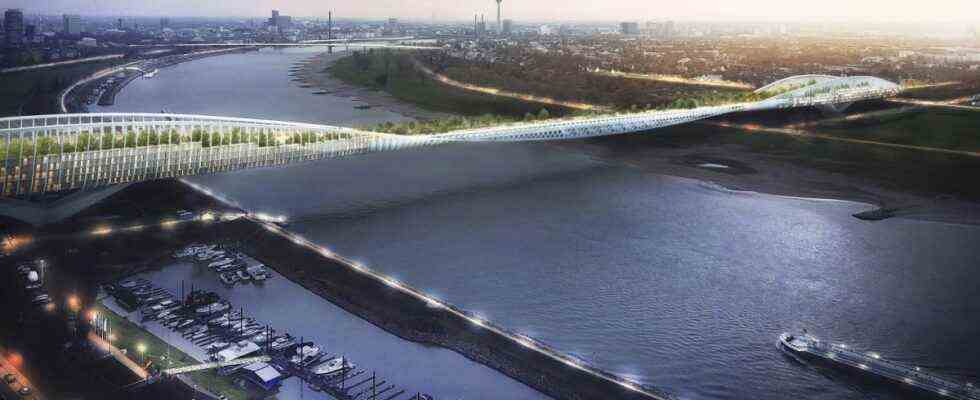Before a stubborn old man from Bavaria was allowed to ruin the papal pontificate, as the cowardly silence from Rome on the abuse scandal teaches us, people liked to remember the Pontifex Maximus. The “supreme bridge builder” was considered someone who is able to unite what is separate. As someone who builds bridges and, in a sometimes wondrous way, ensures that a world can be experienced in a forgiving way that would otherwise remain to itself – on the respective shore.
In all myths, apart from its importance as a supporting structure and its function as a traffic structure, the bridge is a piñata of metaphors. With which one would have arrived at the Rhine and in Düsseldorf, here too the courage to bridge is required. Specifically at the RKW architectural office based there. Officially, so much time has to be given, the office, which has more than 400 employees and belongs to the sumo class of the German architecture industry, trades as “RKW Architektur +”.
One is very tricky on the Rhine with the small cross. But the plus sign is exceptionally sensible – beyond voluminous. This is about the added value of architectural ideas, which you can sometimes even find visionary without having to call for a doctor right away. Urban space utopias belong in the shelter of discursive building culture in times when the same, standardized living shelving sadness is being broken everywhere.
Dieter Schmoll, managing partner of RKW, and Jabra Soliman, associated partner there, have teamed up with Marcel Abel, who in turn is managing director at real estate specialist Jones Lang LaSalle (JLL), for an “initiative draft”. But what this hodgepodge of letters and management titularities cannot prevent is this euphoric line, which out of collegial respect can only be formulated as follows: We are Pope – or at least we could design a pontifex-like bridge on the Rhine in Düsseldorf that the future leads. Into the epoch of urban transformation.
This first cable-stayed bridge in Germany is officially considered dilapidated
An initiative draft is something nobody ordered. In this case, however, it is worth taking a look at the RKW proposal (“design.lab” department) to turn the Theodor-Heuss Bridge, which is in need of renovation, into the “Green Bridge Düsseldorf”. Although one can consider whether the Greens are entitled to a small fee for every “Green” label mantra-like used in architecture. Annalena Baerbock could soon buy Russia and end the Ukraine crisis.
The almost 1.3 kilometer long Theodor Heuss Bridge is Germany’s first cable-stayed bridge (ingeniously designed by the legendary Fritz Leonhardt). Since 1957 it has brought the federal highway 7 across the Rhine in Düsseldorf. Like many bridges in Germany, it is considered “dilapidated” (RKW). In any case, it is in need of repairs. The VW Beetles chugging past here and there in 1957 have become a never-ending stream of heavy loads. Given the load assumptions that nobody could have foreseen, the bridges of the post-war era are hardly sustainable.
Motorized traffic disappears into a tube, while a fast cycle path and a generously dimensioned footpath are organized above it.
(Photo: Design: RKW Architektur + / Visualization: formtool)
The RKW architects therefore propose a radical, even utopian, but also literally memorable conversion of the bridge. A monofunctional traffic bridge is to become something multifunctional. In plain language: New construction instead of renovation. Already at this point, the color green begins to fade somewhat sadly, because the “grey energy” built into the bridge would be lost if it were built again. The question is therefore what added value the new building offers. Because otherwise what Adolf Loos already knew applies: A change that is not an improvement is a deterioration.
The green bridge – of course, dear real estate world, “Green Bridge” sells much better to the global gold concrete group from Dubai to Moscow – it would still be a traffic bridge. But the motorized traffic (car, truck, bus) disappears in a tube, while a high-speed cycle path and a generously dimensioned footpath are organized above it. These paths open up a green band that mediates as a landscape between the banks of the Rhine. According to RKW, “urban gardening” or “farming projects” are conceivable. The green full wash program is lavish.
More than 400 residential units could find space above the water
In addition, 400 residential units are to be accommodated. There, where the new bridge rises up to 47 meters high, in order to replace the previous pylons in a not inelegant curve that accentuates the course of the force. There is even talk of wind turbines and solar panels. The habitable bridge intended as a park (including hotel, restaurant and office use) would also be an ecological flagship project that makes use of wind and sun and provides the climate change with an aesthetic boost.
It is stimulating to think further about the “Living Bridges” of architectural history, ranging from the Old London Bridge to the Ponte Vecchio in Florence. Car-friendly infrastructures could turn into sensationally located parts of the city that serve their residents. What does that cost? Including the “mobility hubs” at the foot of the bridge and, because we’re not spared anything conceptually, including the co-working and car-sharing spaces? “Around 700 million euros,” say the draftsmen, who may be professional optimists. The bridge to the afterlife is for believers.

